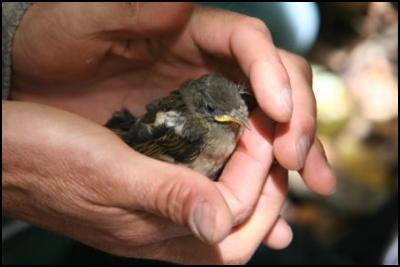Hihi population doubles at Karori Sanctuary
4th January 2006
Hihi population doubles at
Karori Wildlife Sanctuary

This season's breeding at Karori Wildlife Sanctuary has exceeded all expectations with one of New Zealand's rarest birds, hihi (stitchbird), doubling its population in less than a year.
Sixty-four hihi were successfully transferred to the Sanctuary from Tiritiri Matangi Island and Mt Bruce National Wildlife Centre earlier this year. Despite being highly susceptible to stress, the hihi have settled in the Sanctuary extremely well and are thriving. "Hihi have been a difficult species to establish on offshore islands, but they have made themselves at home in the Sanctuary and been very friendly and visible, delighting visitors," said Karori Wildlife Sanctuary Trust chief executive, Nancy McIntosh-Ward.
So comfortable are the hihi in their new surroundings, coupled with the milder winter, that breeding has started early compared with the three island populations further north. It is usual for hihi to have one to two nests in a breeding season and a dozen pairs of hihi are already on their second nests. Seventy-five new hihi chicks have hatched in the Sanctuary to date, with 53 having fledged (left the nest) already. More chicks are expected before the breeding season finishes this summer, boosting the population even further.
"Transferring 64 hihi back to the mainland for the first time was a major milestone for the Sanctuary and indeed New Zealand conservation, but to have them breeding so soon and so prolifically is simply wonderful", said the Sanctuary's conservation scientist, Raewyn Empson. "The rate of breeding, so soon after transferring to the Sanctuary, has exceeded my expectations and is probably the best ever start to a hihi breeding season recorded, be it in the wild or captivity", she said.
The release of hihi in Karori Wildlife Sanctuary was the first step in the Department of Conservation's five year hihi recovery plan, which was launched last February, by Prime Minister Helen Clark and Conservation Minister Chris Carter. The plan aims to bring hihi back to mainland New Zealand after an absence of more than 100 years, and to establish self-sustaining populations.
The transfer of hihi from Tiritiri Matangi Island and Mt Bruce National Wildlife Centre marked their return to the wild on mainland New Zealand for the first time in over 120 years. The new chicks notch up another world first for the Sanctuary, being the first bred in the wild on mainland New Zealand in over 120 years.
Previously, the last time hihi were seen on the mainland was in the Tararua's in the 1880s. The introduction of pest mammals and possibly disease reduced them to a single population on Little Barrier Island around this time. There are two introduced managed hihi populations on Kapiti and Tiritiri Matangi islands. Hihi are one of New Zealand's rarest birds, with a nationally endangered listing.
ENDS


 Natural Hazards Commission: Hub Launched To Empower Architects And Engineers To Build Above Code
Natural Hazards Commission: Hub Launched To Empower Architects And Engineers To Build Above Code Harmony Energy: Ceremony Heralds Start Of Construction On New Zealand’s Largest Solar Farm Project
Harmony Energy: Ceremony Heralds Start Of Construction On New Zealand’s Largest Solar Farm Project Stats NZ: Annual Number Of Home Consents Down 7.4 Percent
Stats NZ: Annual Number Of Home Consents Down 7.4 Percent Plains Media: Plains FM Announces Name Change After 37 Years
Plains Media: Plains FM Announces Name Change After 37 Years NIWA: Flooding From Underneath - New Tool Reveals Shallow Groundwater Elevations
NIWA: Flooding From Underneath - New Tool Reveals Shallow Groundwater Elevations Commerce Commission: Commission Concludes Auckland Airport Over-charging By $190 Million
Commerce Commission: Commission Concludes Auckland Airport Over-charging By $190 Million



